
The view from Mike Schaff’s small airplane is startling. Bayous snake through pastures and swamp forest of Assumption Parish in rural Louisiana. Small residential neighborhoods and gangly networks of petrochemical pipelines, storage tanks and wastewater impounds dot the landscape. In the middle of it all is what looks like a small lake that has spilled into the swamp forest and left patches of cypress trees dead and gray. But the body of dark liquid is not a lake, and it’s not supposed to be there.
We’re flying over Bayou Corne on the one-year anniversary of an unprecedented environmental disaster. The trouble started last May, when small earthquakes rumbled through the area, and fisherman observed the bayous boiling like crawfish pots in certain spots. Then, on August 3, 2012, an underground salt brine cavern collapsed beneath Bayou Corne, and a massive sinkhole opened up on the surface, replacing swamp forest with an expanding slurry pit of oil and salty water from deep underground. Since Truthout first reported on the disaster in December, the sinkhole has grown from eight acres to 24 acres across.
Observers point out that there is at least some good news. While the sinkhole continues to expand, it appears to be growing away from the neighborhood of 150 homes that has been under a continuous evacuation order for the past year.
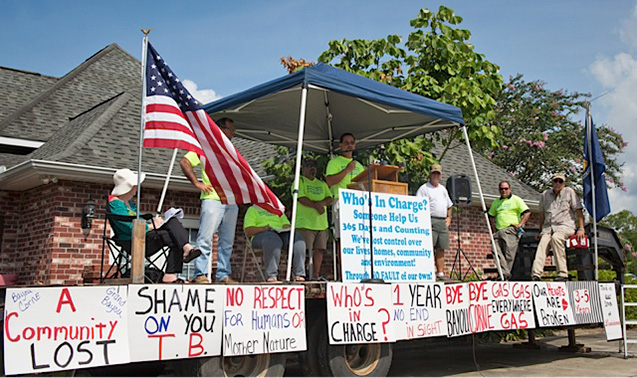 Nick Romero speaking at commemorative ceremony held on day marking one year of the sinkhole.
Nick Romero speaking at commemorative ceremony held on day marking one year of the sinkhole.
Back on solid ground, Schaff cracks a beer and sits down in his kitchen. His house is nestled in the neighborhood less than half a mile from the sinkhole. Like a portion of his 350 neighbors, Schaff has chosen to continue living in his house despite the evacuation order that local officials say is justified by continued threats posed by the sinkhole. Others – especially those raising children, Schaff noted – have left the neighborhood they once called home.
He points to two small air monitors that have been installed to warn him if poisonous and flammable gases creep into his house from underground. Schaff says he is ignoring the evacuation order, which has no clear end in sight, because he doesn’t want to live in a motel room or impose on family and friends. He had planned on spending the rest of his life here, and he refuses to leave unless his house fills up with gas. “If I die here because of gas, then I die here,” he says.
Schaff is angry, and he’s angry with Texas Brine, a Houston-based firm that has operated three underground brine caverns under the sinkhole for decades. The company extracts salty brine, which is used by nearby petrochemical facilities, from a large, dome-shaped salt formation underground. Last year, the wall between one of Texas Brine’s caverns and the salt formation collapsed. Geologists believe that brine and other liquids were forced vertically out of the salt cavern, fracturing rock toward the surface and causing the sinkhole.
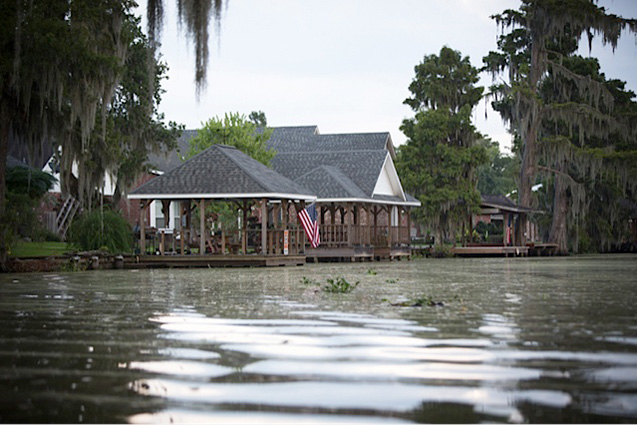 Homes on the banks of Bayou Corne all under mandatory evacuation since Aug 3. 2012.
Homes on the banks of Bayou Corne all under mandatory evacuation since Aug 3. 2012.
The collapsing cavern ruptured underground oil and natural gas deposits, releasing the hydrocarbons into the disturbed earth and contaminating the local aquifer. The gas moves much faster than oil and continues to seep to the surface, causing the bubbling in the bayous and putting the homes in Schaff’s neighborhood at risk.
Under orders from the state, Texas Brine installed 37 vent wells in the aquifer that burn off the gas into the open air. The company reports that daily vent rates are currently down from 160,000 cubic feet of gas to about 17,000 cubic feet. The source of the gas has not been plugged, however, and the aquifer may need to be vented for years.
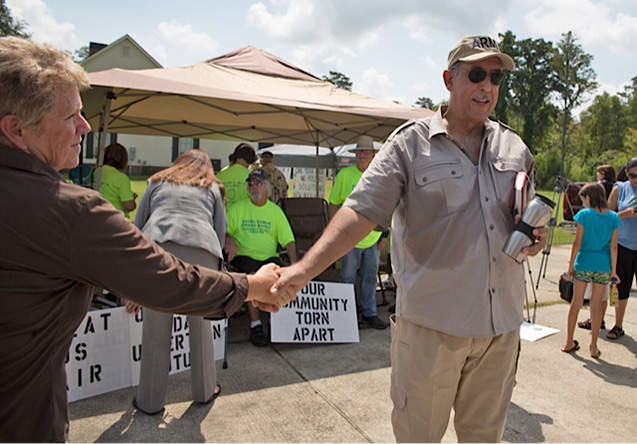 Retired General Russel L. Honoré – an advocate for the community after they asked him for help.
Retired General Russel L. Honoré – an advocate for the community after they asked him for help.
The earthquakes and bubbling bayous were warning signs of the oncoming disaster, but Texas Brine and state investigators did not confirm that the unstable brine cavern was the culprit until a month and a half after the sinkhole appeared. One year later, Texas Brine spokesman Sonny Cranch says that the firm acknowledges that the sinkhole is related to the cavern, but still “no one knows the cause of the breach.” The company operated the cavern for 28 years until 2011, when it was plugged and abandoned after failing a mechanical integrity test. Texas Brine recently filed precautionary lawsuits against three other firms that operate caverns and wells in the area.
About 50 yards from the sinkhole, an active well continues to produce brine from another Texas Brine cavern. Schaff, who recently learned from local media reports that Texas Brine is discussing plans to expand operations at nearby facilities, is frustrated because the company is not focusing all of its efforts on making his neighborhood safe again.
A third cavern at the site is not in operation, and recent seismic tests showed that its sidewall was closer to the salt dome formation that previously thought, prompting the Louisiana governor’s office to prepare a contingency plan in case it collapses as well.
Fighting for Compensation
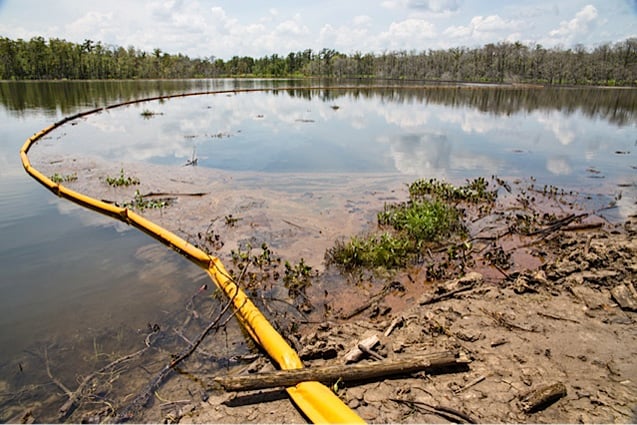 Boom contains oil and other contaminates that rise to the surface of the sinkhole continuously.
Boom contains oil and other contaminates that rise to the surface of the sinkhole continuously.
Texas Brine is actively monitoring seismic activity around the sinkhole, where micro-quakes and “burps” have occurred on a regular basis in recent months. The sinkhole burps, as subsurface structures and the bottom of the slurry pit continue to settle, causing debris and crude hydrocarbons to rise to the surface and disturb the oily water. Residents routinely report that foul, diesel-like odors waft from the sinkhole when it burps, and Schaff says sometimes his eyes burn at night. He wonders what the “cumulative effects” will be on his health.
Cranch says that no volatile organic compounds or other harmful substances have been detected in air around the neighborhood, and the company has been able to keep the sinkhole from contaminating local wetlands and waterways with berms and absorbent booms that regularly collect crude oil from the surface. He says Texas Brine understands the residents’ frustration and is responding to the disaster as responsibly as possible.
Wilma Subra, a technical advisor for the Louisiana Environmental Action Network who has been monitoring the sinkhole, tells a different story. In an address to the media and residents on the sinkhole’s anniversary, Subra said that 84 percent of residents have reported symptoms such as headaches, nose bleeds, mood changes and sleeplessness that are consistent with the kind of chemicals associated with the crude oil in the sinkhole. The burps, she said, make matters worse.
 Moss covered cypress tress along Grand Bayou, behind the sinkhole where methane bubbles up since the sinkhole disrupted the area.
Moss covered cypress tress along Grand Bayou, behind the sinkhole where methane bubbles up since the sinkhole disrupted the area.
Subra said in the address that Texas Brine also allowed unauthorized discharges of pollution into the air and water. “When you come here day after day, you see more and more wetlands destroyed.”
That morning, Schaff, Subra and about 100 others gathered in the driveway of an evacuated home near the sinkhole to observe the one-year anniversary of the day the disaster began. In a speech, Schaff asked why Texas Brine wouldn’t take responsibility for the sinkhole and apologize to his community for permanently altering their lives. How many residents did Texas Brine offer to help move from their homes during the evacuation? How many lawns did the company mow while the residents were away? Why haven’t mental health services been offered to the victims? He said that Texas Brine has not spent one penny voluntarily.
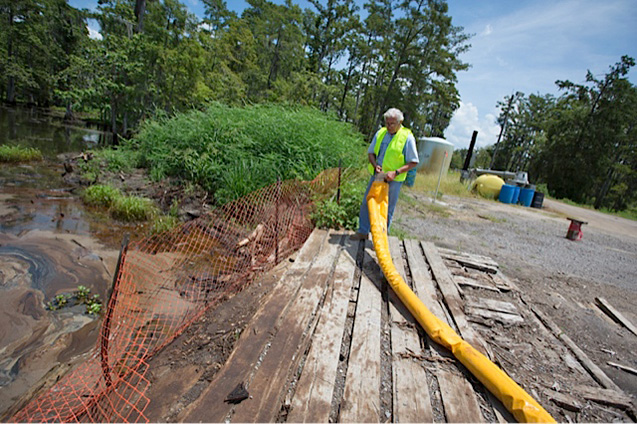 Texas Brine Spokesman’s Sonny Cranch holds a piece of boom next to the oil covered banks of the sinkhole.
Texas Brine Spokesman’s Sonny Cranch holds a piece of boom next to the oil covered banks of the sinkhole.
Texas Brine began handing out weekly checks of $875 per household last year after state officials ordered the company to compensate residents for costs related to the evacuation. Last year, the state penalized Texas Brine with $260,000 in fines for missing cleanup deadlines and failing to comply with orders to install gas monitors and ventilation systems in nearby homes.
Under pressure from local officials and the press, Louisiana Gov. Bobby Jindal stepped up in March to demand that Texas Brine offer to buy out the evacuated homes. Texas Brine has settled buyouts of 63 of the 150 homes in the evacuation zone, and owners of another 30 will continue to negotiate, according to Cranch. Others have filed lawsuits for damages.
Cranch says the company is offering buyouts based on appraisals of property values in early 2012, before the earthquakes and bubbling bayous began alarming locals.
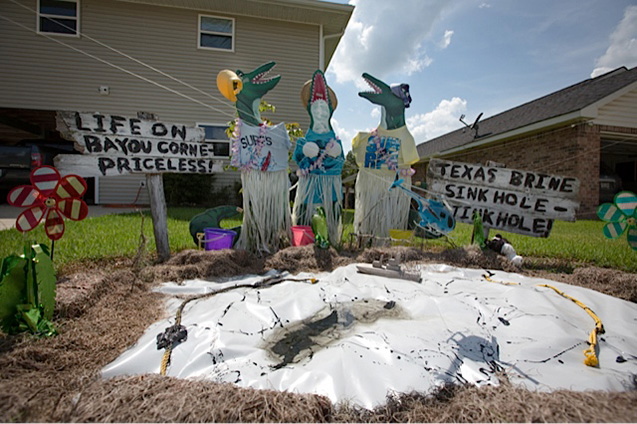 Satirical lawn art in Bayou Corne.
Satirical lawn art in Bayou Corne.
Schaff responds, however, that with hundreds of people displaced by the evacuation, property values in the surrounding area have increased, and the offers made by Texas Brine are not high enough to replace a home with a new house somewhere else.
Like other residents, Schaff met with a third-party moderator, hired by Texas Brine, to negotiate a buyout settlement. Offers and counteroffers were made, but Schaff remained frustrated and left the bargaining table to join in a class action lawsuit. “The process was like dealing with a used car salesman, except this is your life, this is your home,” he says.
Gov. Jindal and local officials recently filed their own lawsuits against Texas Brine and Occidental Chemical Company, which owns the property, for environmental damages cause by the collapsed cavern. The state has already spent $12 million responding to the disaster, and state officials want the companies to pay their fair share.
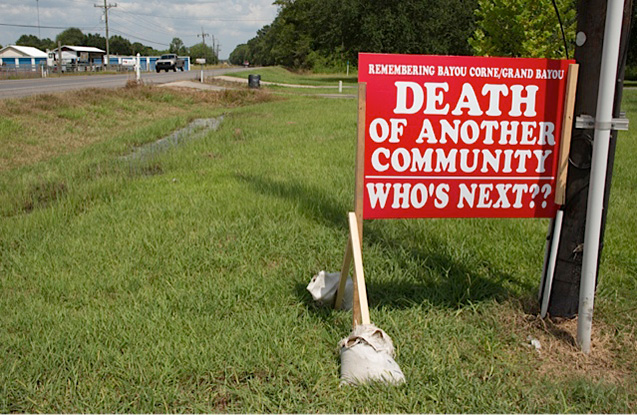 Protest sign on resident’s property.
Protest sign on resident’s property.
“By filing suit, we are staying committed to holding Texas Brine accountable for the damage they’ve caused to Bayou Corne and to Louisiana,” Gov. Jindal said in a statement. “We have already pushed for buyouts for affected residents and are undertaking a thorough review of all of Texas Brine’s permits in our state.”
Louisiana’s lawsuit alleges that the “conduct and operations” of the defendants allowed the cavern to become unstable and collapse, but Cranch is quick to point out that the lawsuit does not accuse Texas Brine of “negligence.”
Lt. General Russel Honore, who lead the Katrina Task Force after the massive hurricane decimated New Orleans and much of the Gulf coast in 2005, recently called on the federal government to provide the community at Bayou Corne with assistance. He also pressed the Environmental Protection Agency (EPA) to take action under the Clean Water Act, but without success.
Truthout asked the regional EPA press office what, if anything, the agency would do about the sinkhole, but a spokesperson failed to respond.
“It’s pathetic, the way these people are being treated,” Honore told Truthout.
 Mike Schaff puts a message up for Texas Brine in his yard in Bayou Corne.
Mike Schaff puts a message up for Texas Brine in his yard in Bayou Corne.
A Somber Anniversary
Legal battles over the sinkhole may wind through the courts for years, but in the meantime, evacuees continue to piece their interrupted lives back together. Evacuee Carla Alleman, who hosted the August 3 anniversary event for the public and the press, said her family has no plans to return home.
“Whether you stayed or you left, your life here has changed for sure,” she told the crowed gathered outside the house she used to live in.
Candy Blanchard is one resident who decided to leave. As the initial days of the evacuation turned into months, she told the crowd outside Alleman’s house, she realized she would never be able to return home. Tears turned into anxiety and then into anger.
“We live in the United States . . . How can business do this to us, and would it be the same if we were a different community?”
Blanchard is frustrated with the idea that she should simply sell her house to Texas Brine and move on. “I’m evacuated from my home, not my house,” she said. “It’s not a piece of real estate.”
Nick Romero lives down the street from Schaff and originally told Truthout in November that he was preparing to evacuate his home with his wife. The couple is currently still in their home, and after failing to negotiate a buyout with Texas Brine, have joined the class action lawsuit against the company. At the anniversary event, Romero spoke of the evacuation and his neighborhood with tears in his eyes.
“They never reached out to find out who you are or what you are, or what you mean to the community,” Romero said of Texas Brine, which, he said, seems only motived by the “almighty dollar . . . They look right through us and don’t see you.”
Romero said he didn’t know anything about an underground salt dome when he moved to Bayou Corne, but he knew he loved fishing in the bayous. “You’d be out there fishing, and you would get a ‘oh wow’ moment,” Romero said. “There’s an alligator over there, there’s a mink scavenging around for something to eat.” With tears in his eyes, Romero said it wasn’t just the natural beauty that made Bayou Corne home. “It was our neighbors, it was you,” he said. “You’re the ones we’re going to miss the most.”
Join us in defending the truth before it’s too late
The future of independent journalism is uncertain, and the consequences of losing it are too grave to ignore. To ensure Truthout remains safe, strong, and free, we need to raise $24,000 by the end of today. Every dollar raised goes directly toward the costs of producing news you can trust.
Please give what you can — because by supporting us with a tax-deductible donation, you’re not just preserving a source of news, you’re helping to safeguard what’s left of our democracy.